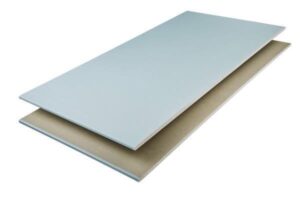Types
- Green board is made from gypsum core with a green paper facing. It is the most common type of moisture resistant plasterboard and is suitable for most applications.
- Blue board is made from gypsum core with a blue paper facing. It is more resistant to moisture than green board and is typically used in areas with extreme humidity levels, such as shower rooms and swimming pools.
The Benefits
- Resistance to moisture: It is designed to withstand high humidity levels without warping, buckling, or deteriorating.
- Mold and mildew resistance: The special paper facing on the plasterboard helps to prevent the growth of mold and mildew, which can be a health hazard.
- Easy installation: Moisture resistant plasterboard is easy to install using standard tools and techniques.
- Cost-effective: It is a cost-effective way to protect your home from moisture damage.
Applications
- Bathrooms
- Kitchens
- Laundry rooms
- Shower rooms
- Swimming pools
- Basements
- Garages
When choosing moisture resistant plasterboard, it is important to consider the following factors:
- The level of humidity in the area where the plasterboard will be used.
- The specific application.
- The budget.
Where to Buy
At Online Insulation Sales, we offer a wide variety of moisture resistant plasterboard products at competitive prices. We also offer fast delivery and expert advice.
























































